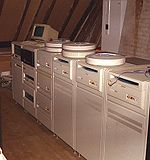PDP-11/44
| PDP-11/44 | |
 PDP-11/44 from a sales brochure. | |
| Manufacturer: | Digital Equipment Corporation |
|---|---|
| Architecture: | PDP-11 |
xs4all.nl
Quoting http://www.xs4all.nl/~geerol/en/GAL/index.html (1979) The PDP 11/44 (hostname "gigant") is a low-cost successor of the PDP 11/70. The 11/70, brought to the market in 1975, was the first "large" PDP. Large means a 22 bit address space and a memory limit of 4MB. Do keep in mind that user programs are still limited to 16 bit addressing and hence restricted to a limit of just 2x 64KB, when using separated I&D.
The cost of a new 11/44 has been about half of the listprice of an 11/70. The PDP 11/44 had no Massbus like the /70 has, so it was not possible to use diskdrives with a transfer rate too high.
hampage.hu
Quoting: 1979. A middle-class -11. It had the 22-bit UNIBUS map and MMU as standard (up to 2 Mwords on a separate CPU-memory interconnect, called the PAX Memory Bus). The CPU consists of 5 boards, plus one for the FPP (FP11-F, optional), and two CIS (KE44-A, optional). Features: 8 KByte cache, ODT, 2 SLU's (Serial Line Units: console + TU58 console media), RTC (Real-Time Clock), kernel/supervisor/user modes.
The machine also had an almost-FEP (front-end processor) console, based on the Intel i8088, running from PROM. There was no qbus equivalent.
Trivia: This was the last non-microprocessor-based PDP-11 (it used LSI bitslice processors).
| v • d • e PDP-11 Computers and Peripherals |
|---|
| UNIBUS PDP-11s - PDP-11/20 • PDP-11/15 • PDP-11/35 • PDP-11/40 • PDP-11/45 • PDP-11/50 • PDP-11/55 • PDP-11/70 PDP-11/05 • PDP-11/10 • PDP-11/04 • PDP-11/34 • PDP-11/60 • PDP-11/44 • PDP-11/24 • PDP-11/84 • PDP-11/94 QBUS PDP-11s - PDP-11/03 • PDP-11/23 • PDP-11/23+ • MicroPDP-11/73 • MicroPDP-11/53 • MicroPDP-11/83 • MicroPDP-11/93 QBUS CPUs: LSI-11 • LSI-11/2 • KDF11-A • KDF11-B • KDJ11-A • KDJ11-B • KDJ11-D • KDJ11-E Buses: UNIBUS • UNIBUS map • SPC • MUD • EUB • QBUS • CD interconnect • PMI Also: PDP-11 architecture • PDP-11 Extended Instruction Set • FP11 floating point • PDP-11 Memory Management |
| UNIBUS CPUs: KA11 • KC11 • KB11-A • KB11-B • KB11-C • KB11-D • KD11-A • KD11-B • KD11-D • KD11-E • KD11-EA • KD11-K • KD11-Z • KDF11-U
Co-processors: FP11-A • FP11-B • FP11-C • FP11-E • FP11-F • KE44-A • FPF11 Chips: LSI-11 • KEV11-A • KEV11-B • KEV11-C • F-11 • KEF11-A • KTF11-A • T-11 • J-11 • FPJ11 CPU options: KE11-E • KE11-F • KJ11-A • KT11-C • KT11-D • KK11-A • KK11-B • KT24 • KTJ11-B Rare CPU options: KS11 Memory Protection and Relocation option • KT11-B Paging Option • KUV11 Writeable Control Store Front panels: KY11-A • KY11-D • KY11-J • KY11-LA • KY11-LB • KY11-P More on buses: UNIBUS and QBUS termination • Bus Arbitration on the Unibus and QBUS • CTI BUS PDT-11s - PDT-11/110 • PDT-11/130 • PDT-11/150 CTI PDP-11s - PRO-325 • PRO-350 • PRO-380 Other: FIS floating point • PDP-11 Commercial Instruction Set • PDP-11 stacks • PDP-11 family differences |
